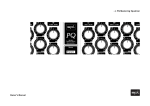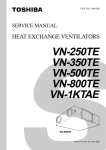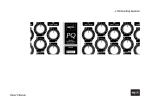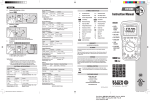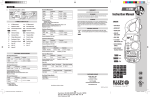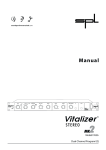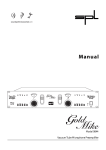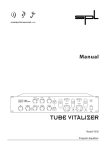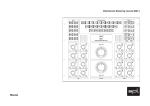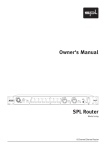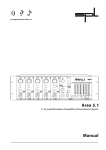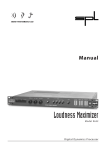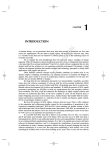Download Sound Performance Lab 2048 User's Manual
Transcript
Manual Model 2048 Parametric 5-Band Stereo Equalizer Manual Stereo Q Model 2048 Version 1.0 – 5/2000 R & D: Wolfgang Neumann The information in this document has been carefully verified and is assumed to be correct. However Sound Performance Lab (SPL) reserves the right to modify the product described in this manual at any time. Changes without notice. This document is the property of SPL and may not be copied or reproduced in any manner, in part or full without the authorization of SPL. Limitations of Liability: In no event will SPL be liable for any damages, including loss of data, lost profits, cost of cover or other special, incidental, consequential or indirect damages arising from the use of the unit, however caused and on any theory of liability. This limitation will apply even if SPL or an authorized dealer has been adviced of the possibility of such damage. Sound Performance Lab P.O. Box 12 27 D- 41368 Niederkruechten, Germany Phone +49 - 21 63 / 98 34-0 Fax +49 - 21 63 / 98 34-20 eMail: [email protected] www.soundperformancelab.com © 2000 SPL electronics GmbH. All Rights Reserved. 2 Contents Introduction ................................................................................................................... 4 Features ........................................................................................................................... 5 Hookup ............................................................................................................................. 5 Connections: Rear front/wiring ............................................................................................................ 6 General advices, sockets .............................................................................................. 7 Operation: General Advice Proportional-Q, recommendations for the setting of bandwidth (Q) ............ 8 Power ................................................................................................................................ 9 Active ............................................................................................................................... 9 Sub ..................................................................................................................................... 9 Low ....................................................................................................................................10 Mid .....................................................................................................................................11 High ...................................................................................................................................11 Air .......................................................................................................................................12 3D Enhancer ...................................................................................................................12 Power Supply .................................................................................................................13 Specifications ...............................................................................................................13 Warranty ..........................................................................................................................14 Copy Master ..................................................................................................................15 Notes ................................................................................................................................16 3 Introduction The Stereo-Q is a parametric 5-band stereo equalizer which excels particularly in two ways: • It is the first stereo equalizer in its class. • The serial-filter design based on the legendary QURE equalizer filter guarantees the high tonal qualities for which SPL-products have become renowned. The continuously increasing number of stereo equipment such as stereo keyboards, samplers or guitar amplifiers together with the broad spectrum of sundry stereo effect gear reinforces the need for utilization of stereo equalizers. Furthermore the processing of stereo tracks in the console’s subgroups (drums, loops, synth or vocal groups for example) or master tracks is facilitated and improved by using a stereo EQ. All control functions for both channels can be adjusted with one control – a large time saver. It is extremely important however that both channels are assured of being adjusted equally. Differing adjustments could cause unsuitable correlations of the stereo program, the correction of which is very complicated. The close adjustment-tolerances of the Stereo-Q reliably avoid this problem which makes it an extremely suitable unit for inclusion in a 5.1 surround studio where the need for coherent twin matching of both channels (front L/R or surround L/R) is paramount. Even small and medium sized recording studios are now in a position to produce high quality masters. Keyboard players or guitarists are provided with the perfect tool for fast production of stereo signals with outstanding tonal properties. The filter circuits of the Stereo-Q are serially constructed which prevents mutual influencing of the filters. All components used are of high and selected quality. Great value was laid on the selection of high quality capacitors for incorporation into the frequency determining components. Additionally the design of a clearly arranged front panel with comprehensive legible scaling was given high priority; large handy buttons with detented potentiometers guarantee a fast and assured adjustment. 4 Features • Three fully parametric bands in accordance with the musically effective proportional-Q-principle, Boost/Cut +/- 15 dB, Q 0.5 to 5; LOW band:10-250 Hz, MID band: 140 Hz-3,5 kHz, HIGH band: 940 Hz to 24 kHz. • Sub-Bass-EQ (Cut/Boost +/- 14 dB, up to 200 Hz) with coil/capacitor filter network that produces a penetrating and lucid deep tone spectrum. The combination of Sub-Bass and Low filter for the processing of the bass spectrum is very effective and opens a new dimension for sound creations. • Air-EQ: the selected coil/capacitor-filter network provides a silky and airy presence – especially in digital recording. • The 3D-Enhancer intensifies the spatial impression of the stereo signal without affecting the low frequency tonal components. • Optional provision of input and output transformers from Lundahl: balancing through transformer stages; the galvanic separation ensures high operational safety. Tonal advantages are offered by the transformer coil. This minimizes odd harmonic distortion and provides a silky top end. • Generally coils sound less aggressive, but produce a rounder and more powerful sound in the deep tone spectrum. This means they possess advantageous musical properties which is why SPL prefers to install coils in the filter area. • Ground: Disturbances which could have an effect over the ground-runs are minimized by the separation of the audio-ground from that of the remaining apparatus. This leads substantially to a higher and ‘cleaner’ tonal quality (in the strictest sense of the word). • Power supply: The toroidal transformer forms the basis for a clean power supply throughout the circuitry. Hookup Carefully select a place for setting up the Stereo Q. The unit should be situated away from heat sources and direct sunlight. Avoid installation in environments exposed to vibrations, dust, heat, cold or moisture. Keep the unit away from transformers or motors or any other unit that could generate large variations in power supply or cause electrical interferences. Do not install the unit in proximity to power amplifiers or digital processors. You may consider placing it in a rack containing other analog gear. Such placement can prevent interference from Word Clock, Smpte, MIDI, etc. • Do not open the case. You may risk electric shock and equipment damages. • Leave repairs and maintenance to a qualified service technician. Should foreign objects fall inside the case, contact your authorized dealer or support person. • To avoid electric shock or fire hazards do not expose your unit to rain or moisture. • In case of lightning unplug the unit. Please unplug the cable by pulling on the plug only; never pull on the cable. Never force a switch or knob. • To clean the case use a lint-free cloth. Avoid cleaning agents as they may damage the chassis. Manufactured in standard 19" EIA format, it utilizes two rack units. • Please support the back of the unit whenever it is being mounted into a 19" rack (especially important when touring). 5 6 Console outputs, insert sends 2 3 1 Pin wiring XLR input 1 = GND, 2 = hot (+), 3 = cold (-) Outputs (XLR or Jack) All stereo signals (or 2 x Mono) Inputs (XLR or Jack) 1 3 2 Console inputs/ stereo returns or inserts of any equipment Sampler Pin wiring XLR output 1 = GND, 2 = hot (+), 3 = cold (-) Guitar amp Stereo mic preamp Pin wiring stereo jack connectors Tip = hot (+), Ring = cold (-), Sleeve = GND Keyboard Connections Rear front/ wiring Connections General Advice Again, while Stereo Q’s housing is EMV-proof and protects against HF-interference, placement of the unit is very important. Please read hookup instructions first (page 4). Before connecting the the unit or any other equipment turn off all power. Adjust the voltage setting on the back so that it corresponds with the power conditions. Pin wirings for balanced and unbalanced operation (XLR and Jack) Tip = + Tip = + Ring = - Ring = GND Sleeve = GND Sleeve = GND The diagrams show the correct polarity for balanced XLR or Jack connectors, if unbalanced wiring is needed. Alternatively unbalanced signals can be connected with mono Jack connectors to the balanced Jack sockets. Balanced Unbalanced Sockets Connections Generally all stereo signal equipment can be connected to the Stereo Q. The diagrams on page 6 show various examples and their method of connection, whether by XLR or Jack connectors. It is of course possible to process mono signals either singly or in pairs (if identical processing is required ...). In order to keep the purest signal quality, input and output level controls were intetionally ignored.The Stereo Q processes all signals in a ratio 1:1 with a working level of 0 dBu – in other words the signals are processed exactly as they come in. 7 Operation General Advice Proportional-Q principle info Low-, Mid- and High filters operate to the proportional-Q principle. This means that maximum possible boost and cut is dependant upon the selected bandwidth. If the bandwidth is increased the measure of boost or cut (=amplitude) decreases automatically with the setting of the Cut/Boost control. Obversely the amplitude increases automatically as the bandwidth decreases. This has two practical advantages: a large bandwidth is automatically treated more sensitively than a narrower bandwidth. This is in line with human hearing sensitivity and allows efficient processing. In addition further adjustment of the Cut/Boost control is no longer necessary when the bandwidth is varied. With other common, constant-Q EQs an increase of the bandwidth leads to magnification of the overall volume so that the processed band sounds unnatural and unmusical. Recommendations for the setting of bandwidth (Q) To some degree the bandwidth shown on the unit relates in inverse proportion to the octave bandwidth displayed, which is often used to describe the bandwidth. The maximum adjustable Q-value 5 (narrowest bandwidth) relates to approximately 0.2 octaves on the Stereo Q; the minimum Q-value 0.5 (greatest bandwidth) is approximately 2 octaves. Bandwidth adjustment is always dependant on the program or instruments to be used. It is not possible to lay down hard and fast rules but the following recommendations are provided: Q-values between 1 and 2 are as a general rule most suitable for processing of voices, keyboards or acoustic instruments with inbuilt microphones. High Q-values between 3 and 5 are often used for processing of extremely high frequency spectrums to enable accurate correction. Larger bandwidths are utilized in the high tonal range when, for instance, refinement of muffled material over a broad bandwidth is required. Nevertheless the air band filter of the Stereo-Q already produces excellent results in this respect so that the high band filter can be used to achieve even further accurate correction. In the bass range larger bandwidths (approx. Q 0.5 to 0.8) are more frequently selected to provide even processing of the deep tonal ranges. However the possibility of a combination of Sub Bass and Low filters should be considered because this permits broad band processing with the Sub Bass and precise correction on the low band. Generally medium Q-values (approx. 0.8 to 1.2) are suitable for frequency ranges from 100 Hz to 700 Hz. 8 Power, Active, Sub Bass Operation Power The power switch is used to turn the unit on or off.The positive and negative paths of the power supply are separated in front of the power unit to ensure that the switched off unit is reliably separated from the mains current. The lamp in the power switch is powered directly from the mains current in conformity with CE-regulations, enabling easier detection of faults: If the power lamp is not illuminated the reason is probably a defective mains fuse. If the power switch is illuminated but, for instance, the activated Active switch is not, this points to a fault in the power unit. Power supply in conformity with CE regulations If there is a power failure (no mains power or unit switched off ) a hardbypass relay for each channel switches the signal directly from the inputs to the outputs thereby maintaining a signal flow under all circumstances. Hard bypass relay maintains signal flow Active Active switches the electronics via the hard bypass relais into the signal path. The button switches a crackle-free relay and offers a fast comparison between the processed and unprocessed signal. To protect the entire electronic circuitry the Active switch should be used when the unit is deactivated for a short period. The power switch should only be used when the equipment is to be turned off for a longer period and it is worth while. Sub Bass The Sub Bass filter spans a range of 10 - 200 Hz (Frequency control). The maximum possible boost or cut is +/- 14 dB (Cut/Boost control).This filter is a passive network comprised of a capacitor, resistor and coil.The inductivity of the coil possesses advantageous acoustic properties in comparison to pure electronic filter stages. The build-up and decay behavior of the coil is somewhat tardy but in this manner rounder-sounding bass tones are provided. > 9 Operation Low Coils additionally produce a more pleasant harmonic spectrum, which is especially important for the precision and tangibility of bass sounds. The Sub Bass filter is exceptionally suitable in presenting voluminous and powerful deep bass sound and produces a fat bass layer. In combination with the Low filter extensive possibilities for processing of bass sounds are provided. This way it is possible to produce a beautiful bass layer with the Sub Bass filter into which frequency-selected accents – using the Low filter – can be interspersed. Instruments provided with such processing give a powerful bass foundation with clear definition; impure bass equalization is eradicated. Low The Low filter spans the frequency range of 10 to 250 Hz (Frequency control). It can be described as a decisive low band filter that in distinction to many comparable concepts deals exclusively with the low tonal range and in this manner can be utilized very accurately and with high sensitivity. The maximal amplification or reduction (Cut/Boost control) of the selected frequency is +/- 15 dB. The Q factor can be varied from 0.5 to 5 Q with the Bandwidth control. A lower Q factor determines a larger bandwidth at the selected frequency, whereas a greater Q factor defines a smaller bandwidth. Please read the information about proportional-Q principle of the filter and the recommendation of setting of bandwidth on page 8. 10 Mid, High Operation Mid The Mid filter covers a frequency range of 140 Hz to 3.5 kHz (Frequency control). The frequency range of the Mid filter reaching down to 140 Hz offers a problem-free access to sounds in this range. This means that a snare which operates often around 160 Hz can be processed with the Mid filter, leaving the Low filter free for other instruments. The maximum cut and boost (Cut/Boost control) of the selected frequency is +/- 15 dB. The Q factor can be varied from 0.5 to 5 Q with the Bandwidth control. A lower Q factor relates to a larger bandwidth at the selected frequency whereas a larger Q factor defines a smaller bandwidth. Please read the information about proportional-Q principle of the filter and the recommendation of setting of bandwidth on page 8. High The High filter spans the frequency range from 940 Hz to 24 kHz (Frequency control). The High filter is utilized in the first place for narrow band corrections, whether to eliminate interference frequencies (e.g. pilot reference) or to accentuate certain frequencies. The combination of High and Air band offers excellent possibilities for the processing of the high frequencies, thereby permitting the High filter for example to be used for precise adjustments while the Air filter is providing a silky top end. The maximum boost or cut (Cut/Boost control) of the selected frequency is +/- 15 dB. The Q factor can be varied from 0.5 to 5 Q with the Bandwidth control. A lower Q factor relates to a larger bandwidth at the selected frequency whereas a larger Q factor defines a smaller bandwidth. Please read the information about proportional-Q principle of the filter and the recommendation of setting of bandwidth on page 8. 11 Operation Air, 3D Enhancer Air The Air filter comprises of a passive network of capacitor, resistor and coil in the same way as the Sub Bass filter. It possesses a so called bell-characteristic with a center frequency at 17.5 kHz. At this frequency the maximal possible boost or cut is +/- 9 dB. The inductivity of the coil possesses advantageous acoustic properties in comparison to simple condenser resistor filter stages. The build-up and decay behavior of the coil is somewhat sluggish which in this case provides softer sound characteristics. Besides this coils produce a more pleasant harmonic spectrum so that processed signals obtain a vastly improved presence. The Air filter is excellently suited to improve the presence of the high frequency range and to produce a silky tonal atmosphere. This is an important aspect for example in the restoration and tonal improvement of old recordings.This in combination with the High filter provides extensive possibilities for processing the top end. With the Air filter a brilliant top end can be produced over which the High filter can superimpose frequency selective accents. 3D Enhancer The 3D Enhancer serves the expansion of the stereo base. The circuitry “recognizes” the signal components, that are placed left and right in the stereoscopic image and mixes them inverted to the respective opposite side. In this way a decentralized location of the sound sources is simulated, which magnifies the spatial impression. In this process monophonic signals are weakened. The adjustment range of the 3D Enhancer extends from 1 (= no processing) up to 19 (= maximum processing). In practice values between 6 and 14 have proven to give optimal performance. Dependant on the condition of the original signal the mono compatibility should be monitored with a phase meter when high settings are used. 12 Power Supply Built around a toroidal transformer, the power supply allows for a minimal electromagnetic field with no hum or mechanical noise. The power supply's output side is filtered by an RC circuit to extract noise and hums caused by your power service. 6000µf capacitors smooth out the positive and negative half waves. The supply voltage can be set to 230 V/50 Hz or 115 V/60 Hz. Check your country’s power requirements for the appropriate setting. An AC power cord is included to feed the IEC-spec, 3-prong connector. Transformer, AC cord and IEC-receptacle are VDE, UL and CSA approved. The main fuse is rated at 315mA. Chassis ground and AC ground can be physically disconnected by the “Ground Lift” switch (GND LIFT).This helps to eliminate hums. Specifications Input & Output Instrumentation amplifier, electronically balanced (differential), transformerless Nominal input level ......................................... +6 dB Input impedance .............................................. = 22 kOhms Output impedance........................................... < 600 Ohms Max. input level ................................................. +20 dBu Max. output level .............................................. +20 dBu Minimum load ohms....................................... 600 Ohms Relay Hard Bypass, Power Fail Safety Power Supply Torroidal transformer ..................................... 15 VA Fuse ....................................................................... 315 mA (slow blow) Ground-Lift switch,Voltage selector Dimensions Housing ............................................................... Standard EIA 19"/1U, 482 x 44 x 237 mm Weight .................................................................. 3,4 kg Note: 0 dBu = 0.775 V Subject to change without notice. 13 Warranty SPL electronics GmbH (hereafter called SPL) products are warranted only in the country where purchased, through the authorized SPL distributor in that country, against defects in material or workmanship.The specific period of this limited warranty shall be that which is described to the original retail purchaser by the authorized SPL dealer or distributor at the time of purchase. SPL does not, however, warrant its products against any and all defects: 1) arising out of materials or workmanship not provided or furnished by SPL, or 2) resulting from abnormal use of the product or use in violation of instructions, or 3) in products repaired or serviced by other than authorized SPL repair facilities, or 4) in products with removed or defaced serial numbers, or 5) in components or parts or products expressly warranted by another manufacturer. SPL agrees, through the applicable authorized distributor, to repair or replace defects covered by this limited warranty with parts or products of original or improved design, at its option in each respect, if the defective product is shipped prior to the end of the warranty period to the designated authorized SPL warranty repair facility in the country where purchased, or to the SPL factory in Germany, in the original packaging or a replacement supplied by SPL, with all transportation costs and full insurance paid each way by the purchaser or owner. All remedies and the measure of damages are limited to the above services. It is possible that economic loss or injury to person or property may result from the failure of the product; however, even if SPL has been advised of this possibility, this limited warranty does not cover any such consequential or incidental damages. Some states or countries do not allow the limitations or exclusion of incidental or consequential damages, so the above limitation may not apply to you. Any and all warranties, express or implied, arising by law, course of dealing, course of performance, usage of trade, or otherwise, including but not limited to implied warranties of merchantability and fitness for particular, are limited to a period of 1 (one) year from either the date of manufacture. Some states or countries do not allow limitations on how long an implied warranty lasts, so the above limitations may not apply to you. This limited warranty gives you specific legal rights, and you may also have other rights which vary from state to state, country to country. SPL electronics GmbH 41372 Niederkruechten, Germany 14 Sound Engineer: ...................................................... Production: ......................................................... Artist: ...................................................... Date: ........................... Copy Master 15 Notes ..................................................................... ..................................................................... ..................................................................... ..................................................................... ..................................................................... ..................................................................... ..................................................................... ..................................................................... ..................................................................... ..................................................................... ..................................................................... ..................................................................... ..................................................................... ..................................................................... ..................................................................... ..................................................................... ..................................................................... ..................................................................... ..................................................................... ..................................................................... ..................................................................... ..................................................................... ..................................................................... ..................................................................... 16
















